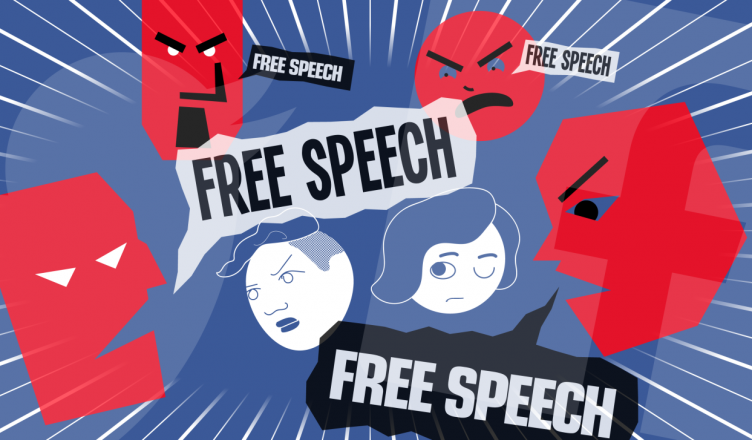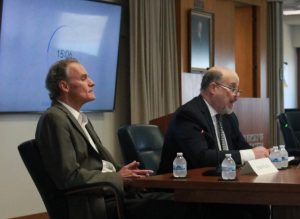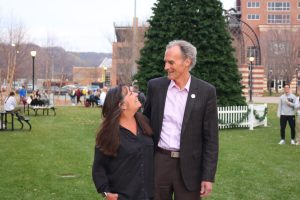The line between hate speech and free speech
April 2, 2019
The first amendment to the United States Constitution guarantees the right to freedom of speech to all Americans, but many are asking, does this clause include hate speech.
According to the American Library Association, there is no legal definition of hate speech. The website says, “Generally, however, hate speech is any form of expression through which speakers intend to vilify, humiliate, or incite hatred against a group or a class of persons.”
“While hate speech is protected by the first amendment, I wholeheartedly believe that while you have a right to say offensive things it doesn’t mean you should,” said the Chairwoman of the College Republicans chapter at University of Wisconsin – La Crosse Kerri Seyfert. “I think this is often misunderstood when groups such as [College Republicans] advocate for free speech, we understand that all speech is protected but in no way do we encourage being hateful.”
“Hate speech is subjective to the individual which is why there is no clear definition,” said Seyfert. “Not only is it protected by the first amendment but because it is so broadly defined it would be impossible to put any sort of restrictions on it.”
Vice Chancellor for Diversity and Inclusion at UWL Barbara Stewart also commented on the rhetoric of hate speech and free speech, “The line between free speech and hate speech is clear when you see that the speech being brought forward is speech that is deliberately denigrating or maligning a person based on their diverse identity.”
“I believe that free speech and hate speech can overlap,” said the Chair of the College Democrats at UWL Adam Vlach, “Someone can advocate for things that are clearly homophobic or racist, and not incite violence in the process. It is hateful to say that gay couples shouldn’t adopt, but it is still within a person’s right to free speech to say that. Where hate speech no longer becomes acceptable is when it promotes violence.”
“I would define hate speech of that which is hateful and bigoted against targeted identity groups,” said the Communications Director for College Republicans Zach Baklund, “But these groups don’t have to be minority representatives in the country. You can be hateful against white people as well as black people.”
As hate speech is technically protected by the first amendment of the United States Constitution, it can be hard to work against hate speech or to prevent others from spreading hate speech at the expense of targeted identities.
“While I may not agree that anyone should be speaking hatefully, there isn’t any instance where legally their right to speak freely isn’t defended,” said Baklund. “The only type of speech that isn’t protected under the first amendment is obscenity, fighting words, defamation, including libel and slander, perjury, blackmail, incitement to imminent lawless action, true threats, and solicitations to commit crimes.”
However, there are some things every person can do to help combat hate speech when they encounter it.
“On a college campus there is usually some process to report hate speech,” said Stewart. “In addition, I would expect there to be some response from the campus, whether it be policy review, a formal investigation, workshops and speakers to educate others about the damage that hate speech can cause.”
In day-to-day life, there are several different ways to combat hate speech, if one chooses to do so. “It is up to everyone to be conscious about calling out hate speech,” said Stewart. “This type of speech brings chilling effects to campus climate and makes it hard for those affected to have a positive experience on campus.”
Vlach advocates for education and building awareness. “The best way to respond to hate speech is to call it out, and then explain why it is hate speech,” said Vlach. “Odds are you are not going to change the opinion of the person using hate speech, but you may be able to add some sort of nuance to their opinion. Having inclusive conversations require people to not tolerate racism, homophobia, transphobia, and any sort of bigotry.”
Having inclusive conversations while being conscious of hate speech can be difficult, but Stewart discusses that it proves to be impactful, “My hope is that people will think about what they are saying and be conscious of how their speech might impact or hurt another person. I think it is always helpful to put yourself in someone else’s shoes and go from there.”
“I think this mentality [of having inclusive conversations while being conscious of hate speech] is problematic,” said Seyfert. “When you focus so much on making a conversation inclusive and politically correct, you lose the substance and purpose of the conversation as a whole.”
Hate speech is present everywhere, in every corner of the country, surrounding everyone. Vlach said, “Hate speech has become more tolerated as of late because of the Trump Administration. Hate crimes have risen drastically since Trump’s election and people are more willing to say hateful things about muslims, immigrants, transgender people, etc.”
“I strongly believe in the first amendment and that people should not be punished by their government for voicing their opinions,” said Vlach. “However, that is why it is the responsibility of citizens to combat bigotry whenever it occurs.”







